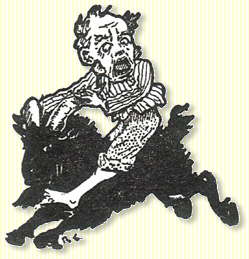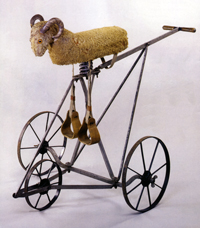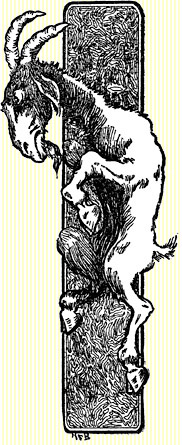 Popular belief has often identified masonic initiation with the riding of a goat. But where, or when did the expression originate? Masonic historians have been at a loss as to the source of this myth, speculating as far afield as the horns on the four corners of the altar used by Old Testament Hebrews and echoed in modern Scottish Rite ritual, or the myth of the goat-headed Baphomet.
Popular belief has often identified masonic initiation with the riding of a goat. But where, or when did the expression originate? Masonic historians have been at a loss as to the source of this myth, speculating as far afield as the horns on the four corners of the altar used by Old Testament Hebrews and echoed in modern Scottish Rite ritual, or the myth of the goat-headed Baphomet. The goat has been both a positive and negative symbol throughout history. In depictions of Pan, and Bacchus, or Dionysius, the goat carried the favorable connotations of youth, merriment, freedom and love. As the attributes of these Greek deities became identified with the Christian Satan, the goat became a symbol for excess, drunkenness, gluttony and licentiousness. Goats represent the souls of the wicked, according to Matthew 25:32-33. For discussion of the rôle of the goat in Greek drama, see Francisco Rodriguez Abrados, Gerald Frank Else (1908-1982), Sir Arthur Wallace Pickard-Cambridge (1873-1952), and Sir William Ridgeway (1853-1926).1 But this may be looking too deeply into what may have once been nothing more than a bit of fraternal humour.
Odd Fellows
Rather than antimasonry, it was in attacks on the Odd Fellows that riding the goat was first claimed to be an aspect of initiation. The anonymous Odd Fellowship Exposed (Exeter New Hampshire, 1845) is the earliest extant attack, while James Madison, in his Exposition (1848) refers to “…the prevalent notion of Masonic and Odd Fellows initiations.”2 By the time the goat came to be associated with all secret societies it was no longer perceived as a malicious slander, perpetrated in an anti-masonic attack, but was merely a jocular euphemism, embraced by many freemasons.
Freemasonry
None of the early exposures of masonic ritual, such as A Mason’s Examination (1723) or Masonry Dissected by Samuel Prichard, London, (1730), or the much later Manual of Freemasonry by Richard Carlisle (1825), make any mention of a goat. Nor is the goat found in Harry Carr’s The Early French Exposures (1971).
The mediaeval usage, as reported in Brewer’s Phrase & Fable, is an historical curiosity but cannot be seen as relevant. |
Although there had been handbills and flyers attacking Freemasonry throughout the eighteenth century, other than the three dozen or more ritual exposures published, the main attacks came from Augustin Barruel (1741-1820) in Mémoires pour servir à l’Histoire du Jacobinisme (1797) and John Robison (1739-1805) in Proofs of a Conspiracy… (1797). Neither suggested that a goat played any rôle in the masonic lodge. But they were, respectively, a cleric and an academic, and stories of goat riding may have possibly circulated in other, earthier, social sets.
First applied to masonic initiation in the 1840s, by century’s end the expression was a popular addition to masonic humour, and a real aspect of other fraternal societies.3
Albert G. Mackey, in his Encyclopedia of Freemasonry (1873) cites the Rev. Dr. George Oliver in recording a common belief of the early nineteenth century that freemasons practiced some form of witchcraft:
“Doctor Oliver says, it was in England a common belief that the Freemasons were accustomed in their Lodges “to raise the Devil.” So the riding of the goat, which was believed to be practised by the witches, was transferred to the Freemasons; and the saying remains to this day, although the belief has long since died out.”4
A few of the more inflammatory pamphlets of the mid-eighteenth century did accuse freemasons of satanic practices, but Mackey fails to provide any documentation for his claim that these were the source of the expression, “riding the goat.” Mackey may record the expression as being common in 1873 America, but Oliver does not confirm its use in 1847 England.
North American fraternities
It is also a curious fact that another North American fraternal society, the Benevolent and Protective Order of Elks, claims to have actually used a goat in its initiation ritual. Prior to 1952, when the blindfolding of candidates was done away with, a range of pranks were played upon incoming members. Reports have it that a widespread practice was for each candidate to ride a live goat around the lodge room.5
 |
The Modern Woodmen of the World—created in Iowa in 1883—made use of a mechanical goat. A major promoter of the Modern Woodmen was Ed DeMoulin who started DeMoulin Bros. in 1890 to cater to, and promote, the use of an ever-expanding list of initiation devices.6 The growth of the Modern Woodmen may have encouraged other North American fraternities to adopt similar practices. A 1915 published ritual of the Modern Woodmen has a list of all of the articles used in the ceremony, including a goat.7
There was certainly no secret about the Woodmen goat. A special correspondence to the LeMars Sentinel newspaper on 12 September 1898 wrote: “Elam Chapman got so excited over riding the goat at the Woodman Lodge lastSaturday night that he forgot his wife and left her here in town, drove homealone and forced his way into the house through a cellar window and had thekey in his pocket.” A music school fraternity founded in Boston in 1898, Phi Mu Alpha Sinfonia, ‘held regular fornightly meetings, one of the main features of which was the initiation of new members by a mysterious process called “riding the goat.”‘ 8
In a similar vein, the New Westminster British Columbian of December 30, 1863, noted:
“Masonic Festival: The Brethren of Union Lodge, No. 1201, in this City sat down to a sumptuous dinner on Monday evening. Not having yet taken a ride upon the mystical goat, we cannot say more than that the affair passed off well. Messrs. Smith and Bridgman were the caterers.”
When one contemplates the image of a 50 kilo goat carrying an 80 kilo mature man, or considers the logistics of keeping a live goat in an urban environment, one is left with the suspicion that anecdotes of goat-riding refer to one of Ed DeMoulin’s contraptions and not to a live farm animal.
Literary references to riding the goat—in poem, song, prose and drama—abound in the nineteenth and early twentieth centuries. The anonymous poem, When Father Rode The Goat is clearly intended as a jocular burlesque and not as an exposure of actual lodge practice.
When Father Rode The Goat The house is full of arnica
The house is full of arnica
And mystery profound;
We do not dare to run about
Or make the slightest sound;
We leave the big piano shut
And do not strike a note;
The doctor’s been here seven times
Since father rode the goat.
He joined the lodge a week ago —
Got in at 4 a.m.
And sixteen brethren brought him home
Though he says he brought them.
His wrist WAS sprained and one big rip,
Had rent his Sunday coat —
There must have been a lively time
When father rode the goat.
He’s resting on the couch to-day!
And practicing his signs —
The hailing signal, working grip,
And other monkeyshines;
He mutters passwords ‘neath his breath,
And other things he’ll quote —
They surely had an evening’s work
When father rode the goat.
He has a gorgeous uniform,
All gold and red and blue;
A bat with plunges and yellow braid,
And golden badges too.
But, somehow, when we mention it,
He wears a look so grim
We wonder if he rode the goat
Or if the goat rode him.9
Popularization
A few examples will suffice to demonstrate the prevalence of a popular knowledge or belief in fraternal goat-riding. The anonymously written Free Masonry Exposed (1871)10 has a humourous account in which a wife demands to know what went on at the lodge. The husband, Mr. Bricktop, divulges to his wife, Emily Jane, the secrets of Freemasonry, including a ride on a goat during the “Fellow-Calf degree.” The story ends with the revelation that the wife knew all along that her husband had been lying. This may have been the inspiration for an 1898 film entitled Riding the Goat. While not the origin of the story, Free Masonry Exposed certainly popularized the image and brought it to the attention of a wider masonic audience.
By the early twentieth century, riding the goat had truly entered the mainstream. American artist Cassius Coolidge (1844-1934) is remembered today for his early twentieth century “Dogs Playing Poker” series of illustrations, one of which was titled “Riding The Goat”. Charles Francis Bourke’s short story Riding the Goat was published in The Cavalier for 15 June 1912 and Frank Gee Patchin’s 1910 novel for boys, The Pony Rider Boys in Montana included the chapter, “Chunky Rides the Goat”.11
In Bobby Bumps Starts a Lodge (1914), the candidate doesn’t ride a goat, but he wears an apron with a goat’s head emblem and is initiated by being butted by a goat. In 1922, Bud Fisher, creator of the comic strip Mutt and Jeff, wrote and directed a black and white silent cartoon short, also entitled Riding the Goat. The one-act play, Riding the Goat12 (1929) by May Miller [Sullivan] (1899-1995), refers in the dialogue to a fictional fraternal lodge initiation, but also uses the title as a metaphor for initiation in life, as one grows and learns.
Bro. Sir Lionel Brett tells us :
The name “Boaz” occurs frequently in the accounts of the building of K.S.T. The Polyglot Bible gives the meaning as ‘in it is strength’, but Cruden’s Concordance, first published in 1737, gives ‘in strength or in the goat.’ I am told by Hebrew scholars that ‘in the goat’ is the misreading of the component parts of the word, but the misreading may explain the buffoonery which I have heard of as practiced on candidates in some places.13
The expression is also known outside of English-speaking Freemasonry. In the Afrikaans of South Africa, up to the present time, freemasons are called “bok ryers” or “goat riders”.
Outside the literary world, there is also a report from Te Hana, New Zealand, of a simple stonemasons’ device, used to move heavy stone blocks, called a goat. 14
That there was ever a popular belief in masonic goat-riding has not been demonstrated, although one South African ministry appears to have accepted the fiction as fact.15 Like the purported practices of the Gormogons and Scald-Miserables16, the story of the goat—although perhaps inspired by mediaeval superstition and promoted by anti-masonic attacks—may have only represented a literary burlesque intended to poke fun at fraternal initiation, and was never a widespread belief. In its humorous form it is clear that the story has been kept alive by freemasons and not by anti-masons.
1.
James A. Ovas, Freemasonry in the Province of Manitoba, Published by Northern Light Lodge, A.F. & A.M., No. 10, G.R. Manitoba [1913] p. 7. |
